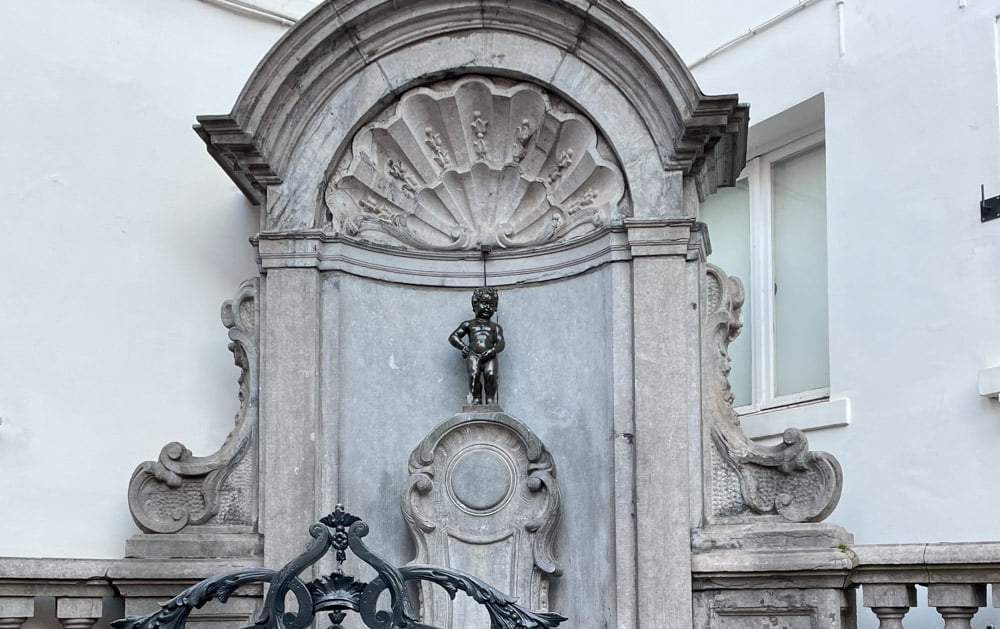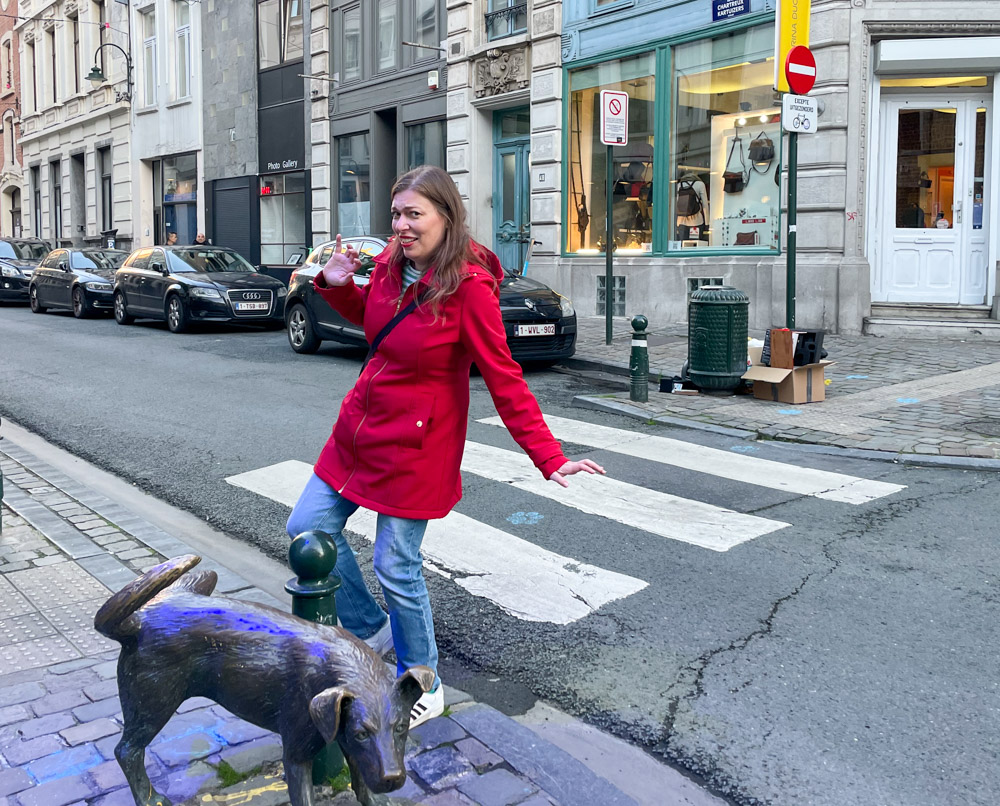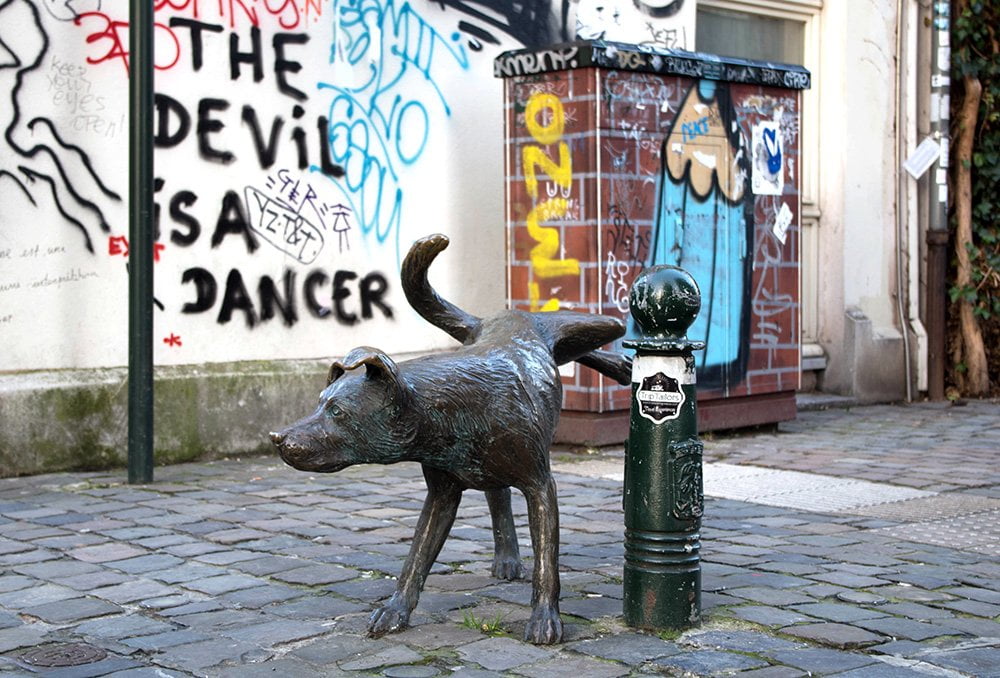The Manneken Pis statue is one of the most famous and funny symbols of Brussels. Still, it is not the only statue in the city representing a child (or animal) urinating. You can find other similar sculptures in the Belgian capital, such as the little girl Jeanneke Pis and the dog Zinneke Pis. The origin of these statues dates back centuries, and although they may look decidedly extravagant, for the people of Brussels, they represent a symbol of pride and cultural identity.
Table of Contents
Manneken Pis: the peeing kid symbol of Brussels
Manneken Pis, which literally means the little man who pees, is certainly the best-known urinating statue in Brussels. Just over 55 centimetres high and located a few steps away from the Grand Place, the statue personifies the Belgian sense of humour and independence of spirit.
PLAN YOUR TRIP TO BRUSSELS
Make the most of your trip to Brussels by purchasing the Brussels City Card online. With access to the city’s top museums and free public transport, it’s the smartest way to explore the city and save money.
To stay connected in Brussels, purchase an Airalo eSim online for phone and data coverage during your trip to Belgium.
History of the Manneken Pis
The origin of the Manneken Pis statue is uncertain. The first mention of its existence appears in an administrative text from around 1451, relating to the aqueduct that supplied the fountains of Brussels, as it initially served to supply drinking water to the citizens. The statue of the pissing child and the fountain also appear in a painting and preparatory drawing by Denis Van Alsloot from 1615.
Jérôme Duquesnoy the Elder made the current version of the Manneken Pis in 1619. He was a very famous Brussels sculptor at the time. Initially the fountain had a column and a rectangular double basin, later replaced. In 1770 the Manneken Pis ended up into a stone decoration from a dismantled Brussels fountain.
From 1851, a gate protects the statue of Manneken Pis, preventing access to the water. While pther fountains in Brussels supplied drinking water to homes, the pissing kid took a purely decorative role.
However, this Manneken Pis statue is not the original one. The original statue, sculpted by Jérôme Duquesnoy the Elder, is now in the Museum of the City of Brussels, to protect it from new attempts of theft. Admission is free with the Brussels Card.

The attempted thefts of the Manneken Pis
The Manneken Pis statue has been stolen several times and later found or returned. The first documented attempt to steal Manneken Mis dates back to 1747 by French soldiers stationed in Brussels. To calm the situation, King Louis XV of France offered the Manneken Pis an elegant dress, a sword and the decoration of the Cross of St. Louis.
A different story for the statue theft by the criminal Antoine Licas in 1817. He was severely punished, exposed in chains in the Grand Place and then sentenced to hard labour for life. The statue, broken into 11 pieces, was reassembled by a specialist welder, under the supervision of sculptor Gilles-Lambert Godecharle.
The Manneken Pis suffered further theft attempts in the last century. The first, in 1955, was by a group of students from Antwerp who used it to raise money for disabled people. Without legal consequences, they collected an impressive 80,000 Belgian francs.
The subsequent theft in 1965 caused the statue to break, with feet and ankles left on the plinth and the body found in a canal in Charleroi after an anonymous report to the Antwerp magazine De Post.
The Manneken Pis wardrobe
While dressing up religious statues has been widespread throughout Europe since the Middle Ages, dressing up a non-religious statue is a decidedly exceptional custom. The only explaination is the importance that the Manneken-Pis has gradually assumed in Brussels.
The tradition of dressing up the statue to mark the annual festivities has been documented for centuries. The oldest evidence of this tradition dates back to 1615. He was dressed up as a shepherd for the festivities organised for the archduchess Isabella. Even today, Manneken Pis wears the most curious costumes.
Besides the dress given by King Louis XV of France to make up for the theft by his soldiers, the Manneken Pis received other gifts from noblemen and state officials. For example, in 1695, Governor General Maximilian Emmanuel of Bavaria, stationed in Brussels, gave him a dress in Bavarian blue.
Today, the Manneken Pis boasts a wardrobe of about a thousand costumes on display in the Museum of the City of Brussels. Admission is free with the Brussels Card so that you can browse freely among the most extravagant costumes. They have different themes and range from gala outfits to folkloric costumes, sportswear or clothes related to famous people.

Jeanneke Pis: the fountain with the peeing girl
Besides the Manneken Pis fountain in Brussels, you can see its female counterpart, the Jeanneke Pis, the little girl who pees. Located in the historical centre of Brussels, in the alley Impasse de la Fidélité, it represents a squatting little girl urinating.
The Jeanneke Pis is a bronze statue created with great attention to detail by sculptor Denis-Adrien Debouvrie in 1985. The intent was to establish equality between the sexes and redress an injustice that had existed for over five centuries.
Although it does not have a wardrobe nor the attention paid to its big brother Manneken Pis, Jeanneke Pis has also, over time, become a popular tourist attraction in Brussels, visited by thousands of people every year.
Jeanneke Pis
Imp. de la Fidélité 10-12
1000 Bruxelles

Zinneke Pis: the statue of the peeing dog
In Brussels, there are not only statues of children peeing. There is also a dog urinating against a bollard, called Zinneke Pis or Het Zinneke, but without any fountain.
The statue of the Zinneke Pis, the pissing dog, is in the Marolles area of Brussels. According to its creator, the figure of the mestizo dog represents the idea of Brussels’ identity, which is composed of different languages and cultures.
As some people found the figure of the urinating dog offensive, the Zinneke Pis statue was the subject of controversy. Still, the majority of the people of Brussels regarded it as a work of art representing Brussel’s humour and identity.
Zinneke Pis
Rue des Chartreux 35
1000 Bruxelles

Where to stay in Brussels
I have visited Brussels many times, and I can confidently say that the city offers a wide range of accommodation options to suit different travel styles. If you are looking for a hotel in the city centre, the Pillows City Hotel Brussels Centre is an excellent choice. It is located just 100 metres from Brussels Central Station and within a five-minute walk of the Grand Place and the Manneken Pis statue, making it ideal for exploring the city on foot.
Right in the heart of Brussels, Made in Catherine is located on Place Sainte-Catherine, only a ten-minute walk from the Grand Place. This small hotel is particularly appreciated for its fantastic buffet breakfast and its lively yet authentic neighbourhood.
In the European Quarter, for an especially romantic stay, Faubourg 21 is a refined five-star hotel offering a spa, wellness centre and a terrace. It is a great option if you want to combine sightseeing with relaxation in an elegant setting.
If you prefer staying in an apartment, Teddy Picker offers well-designed studios with a garden or terrace. The property also features a family-friendly restaurant serving Belgian and international cuisine for lunch and dinner, including vegetarian and vegan options.
You can discover all the pissing statues in Brussels with a short walk through the historic centre of the Belgian capital. What do you think of these symbols with a curious sense of humour? Share your thoughts in the comments.
